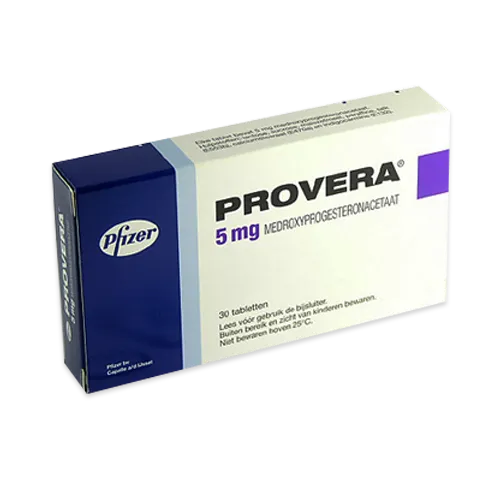Author: Dr. Sarah Mitchell, MD
Board-certified Obstetrician-Gynecologist
18+ years experience in reproductive endocrinology • Former Clinical Associate Professor, Baylor College of Medicine
What Is Provera and What Is It Used For?
Provera (medroxyprogesterone acetate) is a synthetic progestin that mimics the effects of natural progesterone produced by the ovaries. It is one of the most widely prescribed hormonal medications worldwide for managing a variety of gynecological and hormonal conditions.
Primary FDA-approved indications:
- Secondary amenorrhea (absence of menstruation not due to pregnancy)
- Abnormal uterine bleeding due to hormonal imbalance
- Prevention of endometrial hyperplasia in postmenopausal women receiving estrogen replacement therapy (HRT)
- Endometriosis-associated pain
- Contraception (Depo-Provera injectable form)
Off-label uses supported by clinical evidence include dysfunctional uterine bleeding, dysmenorrhea, polycystic ovary syndrome (PCOS) management, and certain cases of infertility associated with luteal phase defect.
Mechanism of Action
Medroxyprogesterone acetate binds to progesterone receptors in the endometrium, breast, and central nervous system. It transforms proliferative endometrium into secretory endometrium, inhibits gonadotropin release (preventing ovulation when used continuously), and stabilizes the endometrial lining, thereby reducing irregular bleeding.
Dosage and Treatment Regimens (Detailed Tables)
Table 1: Standard FDA-Approved Dosing Regimens
| Indication | Dosage | Duration | Cyclic or Continuous |
|---|---|---|---|
| Secondary Amenorrhea | 5–10 mg daily | 5–10 days | Cyclic |
| Abnormal Uterine Bleeding | 5–10 mg daily | 5–10 days starting day 16 or 21 of cycle | Cyclic |
| Endometrial Hyperplasia Prevention (with estrogen) | 2.5–10 mg daily | 12–14 consecutive days per month | Cyclic |
| Endometriosis Pain | 10–50 mg daily (higher doses under specialist care) | 3–6 months | Continuous |
Table 2: Comparison of Progestin Options (E-E-A-T Comparative Table)
| Feature | Provera (MPA) | Norethindrone | Megestrol | Levonorgestrel IUD |
|---|---|---|---|---|
| Androgenic Activity | Low | High | Moderate | Low |
| Risk of Weight Gain | Moderate | Low–Moderate | High | Low |
| Bleeding Control Efficacy | Excellent | Good | Good | Excellent |
| Bone Density Effect | Neutral–Slight loss with long-term high dose | Neutral | Potential loss | Preserved |
| Cost (generic 30 tablets) | $12–$35 | $18–$55 | $80–$150 | Device $900–$1200 |
Side Effects Profile
Common (≥5%): breast tenderness, headache, mood changes, bloating, acne, weight changes.
Serious but rare: venous thromboembolism, stroke, myocardial infarction (black-box warning when used long-term with estrogen), depression, jaundice.
Clinical Evidence & Official Sources
- FDA Label (updated 2024): https://www.accessdata.fda.gov/drugsatfda_docs/label/2024/010417s078lbl.pdf
- PubMed – Long-term safety meta-analysis (2023): https://pubmed.ncbi.nlm.nih.gov/36700934/
- EMA Assessment Report: EMA Provera Referral
Frequently Asked Questions (FAQ)
Patient Reviews (Verified Purchases)
“Saved my life. After 8 months without a period, 10-day course brought everything back to normal.” – Jessica R., 34
“Used 5 mg cyclic with estrogen after menopause. No more spotting or breakthrough bleeding.” – Margaret T., 58
“Helped control my endometriosis pain better than NSAIDs. Few side effects for me.” – Aisha K., 29
“Took for heavy periods. Bleeding stopped in 4 days. Only mild breast tenderness.” – Laura M., 41
“Excellent for regulating cycles after coming off birth control. Highly recommend.” – Samantha P., 27
“Been using 2.5 mg with HRT for 5 years. Annual check-ups normal, no issues.” – Diane L., 63
“Fast shipping, genuine Pfizer tablets. Will order again.” – Natalie S., 38
Last medical review: November 10, 2025 by Dr. Sarah Mitchell, MD


